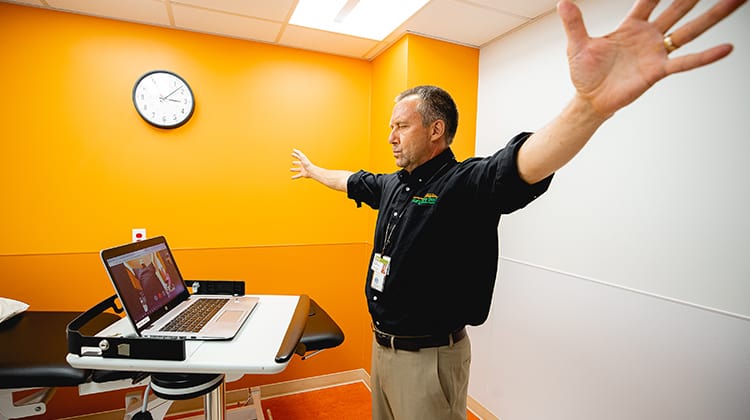Maintaining the Momentum of Recovery
Mary Free Bed is using virtual care to help patients continue their therapy so patients do not lose the momentum of their recovery. Christopher Bajema, PT, OCS, CSCS, Clinical Leader – Musculoskeletal Rehabilitation, Mary Free Bed, recognizes the benefits of using Synzi to help patient improve their movement and manage pain via HIPAA-compliant video and messaging. “During a virtual visit, we can see if the patients are doing the exercises at home in the place where they said they would exercise,” said Chris. We see patients actually do their ‘homework’ in their home environment. It’s impressive to see some of the patients’ home and how they have been creative with the space they have in order to do their exercises.”
- Virtual Visits: During the virtual visits, therapists guide their patients through the exercises needed to optimize outcomes (e.g., more strength and movement with less pain) and reinforce how to correctly do each exercise. “The virtual aspect helps me show patients the motions they can and cannot do at each stage,” says Chris. “For example, in the strengthening phase for a patient who has had shoulder surgery, I will show how one cannot reach back into the backseat of their car – and that one should not reach out to a drive-thru bank teller or fast-food cashier – in order to help the healing process. Patients like to hear what they can do / cannot do in the clinic but they also appreciate hearing – and seeing – it virtually.”
- Messaging: A series of messages are sent to the patient to remind them of the need to “get up and get moving” on a regular basis and fulfill their role in executing their own home exercise plan. “I also send exercises and links to exercise videos to our patients to help them with their homework,” shared Chris.
- Assessments: Assessments can be pushed to the patients before or after each virtual visit to gauge how the patient is feeling as well as the patient’s exercise activities. These assessments enable the therapists to check on the patient’s progress and modify the exercises going forward. “Before each virtual visit, I have to make sure I am ready to engage and also ready to pivot right or left, depending the patient’s situation,” says Chris. “I am able to leverage over 30 years of clinical experience when providing care and physical therapy virtually vs. in-person.”
Providing Safer and Convenient Therapy
During the pandemic, Chris indicated how virtual care enabled MFB to quickly continue seeing patients in a safer and more convenient manner: “Before the pandemic, I used virtual visits with post-op patients’ Day 1 and/or Day 2 and it saved my patients a visit to our facility. During parts of the pandemic, I conducted virtual visits for the majority of my day. And, patients were fine with continuing virtual care when we re-opened our facility to in-person visits. I also see COVID patients virtually and help them with their breathing techniques. This helps their recovery while also minimizing the risk of infection and transmission.”
Patients have shared their satisfaction with Chris:
- “I start the virtual visits with a warm-up to music. I use different music and it helps patients engage and also look forward to the sessions!” Chris shared. “I’ll do the exercises with my patients in the virtual visit. They want me to do the workouts with them so they don’t feel like they’re just exercising in front of a screen.”
- “Our patients thought Synzi was spot-on,” said Chris. “They eagerly anticipate the virtual visits because they see the benefit. Plus, I have received very few cancellations for virtual visits. I can count them [the cancellations] on one-hand! “
Looking to the Future with Teletherapy
The outlook for continuing and expanding the role of virtual care is positive. “My advice to therapists thinking about virtual care is that you just have to do it to get better at it,” shared Chris. “You have to personalize the care to the individual patient’s need. I spend a lot of time watching my patients in motion – and Synzi helps me see them moving in their home environment and also outside of their home. I even watched a patient play tennis as he recovered.”
“I am excited about the future of virtual care to improve value, service, and outcomes,” says Chris Bajema. “Post-pandemic, I hope to move to a hybrid where some in-person visits are replaced by virtual visits because we’re seeing similar outcomes. I’m glad that MFB was prepared with Synzi’s technology in advance of the increased need due to the pandemic… Synzi works like a charm!”

